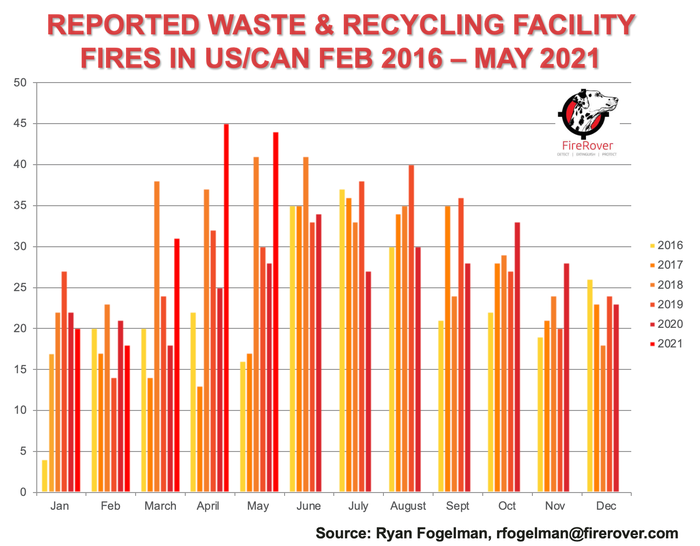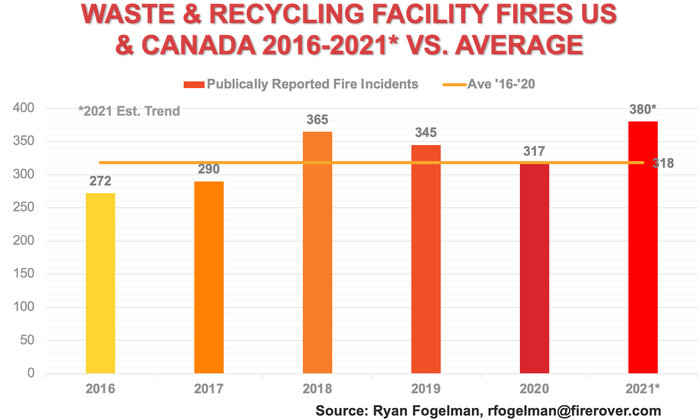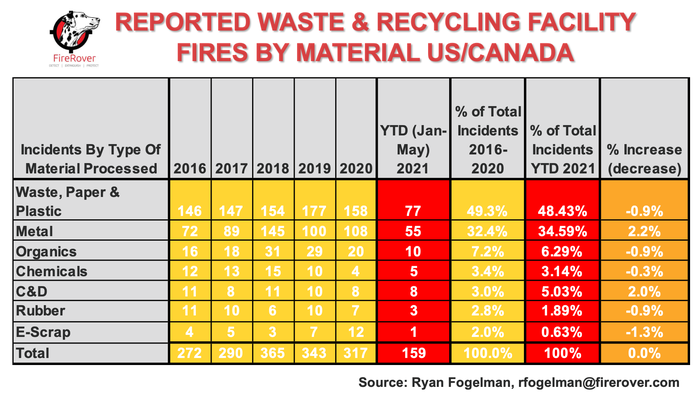May 2021 Fire Report: Is the Pandemic Recovery Driving Record-high Fire Incidents?

The past three months have been the worst on record since I began reporting waste and recycling facility fire incidents in the beginning of 2016. In March, we incurred 31 reported fire incidents, and in April, we incurred 45 waste and recycling facility fires, which was a historical record. Then comes May, when we encountered 44 fire incidents at our waste and recycling facilities in the U.S. and Canada. To put this into perspective, in March-May of last year we only faced 71 total fires compared to this year��’s same period of 120. This number far surpassed the average number of fires we have seen in the past five years including the start of the lithium-ion wave of 2018 where we incurred 116 fires during the same time. At Fire Rover, we responded to 88 fire incidents at our clients’ facilities to go along with the 74 from April.

March, April and May’s fire incidents are not an aberration. The increase in fire incidents is not a one-time thing but instead based on some fundamental factors in the waste and recycling supply chain. To put this into historical perspective, I have updated the annual incident data to include 2021 numbers. The numbers are based on the trend for the first five months of this year, but as you can see pretty clearly, if things don’t change, we are facing the worst year for fires at our waste and recycling facilities since I began keeping records in 2016.

Is there a particular sector driving the increase in fire incidents?
In last month’s article, I analyzed the materials sectors where we were seeing fires and it seemed that we were in line with historical percentages by individual sector. There have been times in the past where certain materials made up a larger percentage of fire incidents and skewed the numbers higher. This month, I took my analysis one step further, updating my material report for the year-to-date numbers versus historical trend.

As you can see, our material sectors are pretty close to historical trends. The issue is the number of fire incidents we are experiencing. If we keep up with this pace, we are going to end the year with a historical high in waste, paper and plastic fires at 183 estimated fire incidents, scrap metal fires at 132 estimated fire incidents and construction and demolition fires at 19 estimated fire incidents.
What possible factors have led to the spike in fires?
When most folks ask me about the possible factors that cause these fire incidents, I typically supply them with the below list.
Traditional Fire Hazards: Unknown hazards of combustibles (i.e., aerosols, butane cans, chemicals, hot ashes, paints, fireworks). These are the same hazards we have seen in our material for decades.
Lithium-ion Batteries: In addition to a large number of these batteries being manufactured and placed incorrectly in our waste and recycling streams, they are combustible and their size makes them almost impossible to remove from the processing streams.
Heat/Dry Environments: We have seen an increase in fires during the summer months, but when we see weather patterns that are dry and hot, we see spikes during other times of the year.
Inherent Risk: Recycling chemicals and hazardous materials has explosive and combustible risk built in, especially when increased temperature is required as part of the recycling process.
Sparks/Hot Works: As buildings/equipment age or volumes increase, more work is required to maintain the equipment.
Arson: Competitive and desperate operators.
It is no secret that due to the factors listed above, I believe there is an inherent risk of fires in our waste and recycling operations. Operators have many approaches to dealing with these risks including education, operational best practices and investment in fire detection and firefighting technologies that can best deal with this inherent risk. The industry is better prepared now that it has been able to deal with all the hazards we face, so what is causing this spike?
The questions we need to ask ourselves during this spike are which risks have potentially been exasperated from the list above, or what other factors might we be faced with during the past few months. In my opinion, we are dealing with the perfect storm of the proliferation of lithium-ion batteries, a hotter spring across the country and some new factors that have been introduced by the pandemic recovery resulting in increased material as well as a staffing shortage.
Lithium-ion Batteries – The number of personal storage and consumer electronics continues to grow and are in all aspects of our waste and recycling streams. Education and implementing best fire prevention tactics are great, but we need to double down and take further steps to eliminate this problem, such as utilizing early detection and fire suppressant solutions that get to the problem before it becomes a major issue.
Heat – I am not going to go as far as some and blame climate change on the increased heat we faced this year, but no one can argue that when the environment is hotter, it equates to more fires in our waste and recycling streams. We have seen this trend consistently each year during the “summertime spike” of reported fires.
Increased Material – Most folks in the business will tell you they have experienced a spike in material tonnage during the past few months. As Americans continue to venture out of their homes, head back to the office and eat at restaurants again, we are starting to see increasing levels of material that we haven’t seen since before the pandemic. The more material we process, the higher the chance of a fire incident.
Staffing Shortage – If you talk to anyone who owns or runs a business, most of them will tell you how hard it is to find, train and keep staff. Add to that the challenges of the pandemic, including social distancing and stay-at-home-orders, and we are faced with a staffing shortage we haven’t seen in decades. In waste and recycling, if you do not have enough staff to run your shifts, it equates to slower processing time for material, leaving more material on your tip floors and in feedstock piles increasing the risk of fires. .
Hopefully the pandemic effect will rightsize itself over time, as we get staffing normalized and new staff trained, plan for more consistent demand and put less stress on the system. The pandemic has thrown many industries for a loop, and our waste and recycling operators have done an amazing job planning for the unplannable and reacting relatively quickly to the ever-changing environmental and economic climate. It is time to get back to the basics and prepare for the future.
Conclusion
As the pandemic winds down and we begin traveling and meeting in person again, I look forward to the opportunity to meet with our industry colleagues to discuss their insights and approaches to dealing with our fire issues at WasteExpo 2021 later this month. I will be moderating a session titled “Evaluating Risk from the Eyes of the Insurer,” held on Wednesday, June 30 at 11:45 a.m. PT in room N227, which I feel will be extremely timely as we continue down the path of maintaining healthy insurance options for our industry colleagues.

The goal of this session is to provide a brief introduction about insurance challenges and opportunities in our industry and to have an interactive conversation between operators and insurers to identify what we need to do from both an industry and individual operator perspective to strive toward a healthy insurance market. If you would like to learn more or submit questions prior to the event, feel free to email me at [email protected]. I’m looking forward to seeing you all at WasteExpo 2021!
Ryan Fogelman, JD/MBA, is vice president of strategic partnerships for Fire Rover. He is focused on bringing innovative safety solutions to market, and two of his solutions have won the distinguished Edison Innovation Award for Industrial Safety and Consumer Products. He has been compiling and publishing the “Reported Waste & Recycling Facility Fires In The US/CAN” since February 2016 and the “Waste & Recycling Facility Fires Annual Report.” Fogelman speaks regularly on the topic of the scope of fire problems facing the waste and recycling industries, detection solutions, proper fire planning and early-stage fire risk mitigation. Additionally, Fogelman is on the National Fire Protection Association’s Technical Committee for Hazard Materials. (Connect with Ryan on LinkedIn at https://www.linkedin.com/in/ryanjayfogelman or email at [email protected])
About the Author
You May Also Like




.png?width=300&auto=webp&quality=80&disable=upscale)